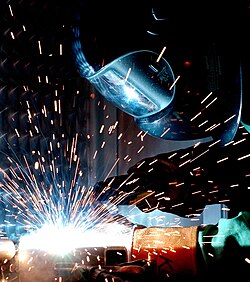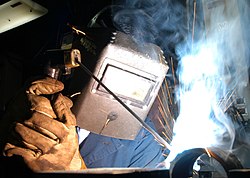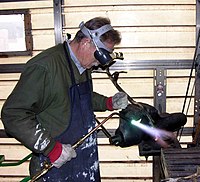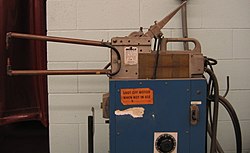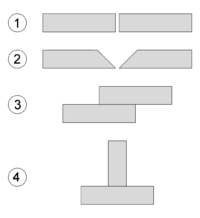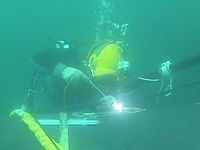Welding
Welding is a fabrication process that joins materials, usually metals or thermoplastics, by causing coalescence. This is often done by melting the workpieces and adding a filler material to form a pool of molten material (the weld puddle) that cools to become a strong joint, but sometimes pressure is used in conjunction with heat, or by itself, to produce the weld. This is in contrast with soldering and brazing, which involve melting a lower-melting-point material between the workpieces to form a bond between them, without melting the workpieces.
Many different energy sources can be used for welding, including a gas flame, an electric arc, a laser, an electron beam, friction, and ultrasound. While often an industrial process, welding can be done in many different environments, including open air, underwater and in space. Regardless of location, however, welding remains dangerous, and precautions must be taken to avoid burns, electric shock, poisonous fumes, and overexposure to ultraviolet light.
Until the end of the 19th century, the only welding process was forge welding, which blacksmiths had used for centuries to join metals by heating and pounding them. Arc welding and oxyfuel welding were among the first processes to develop late in the century, and resistance welding followed soon after. Welding technology advanced quickly during the early 20th century as World War I and World War II drove the demand for reliable and inexpensive joining methods. Following the wars, several modern welding techniques were developed, including manual methods like shielded metal arc welding, now one of the most popular welding methods, as well as semi-automatic and automatic processes such as gas metal arc welding, submerged arc welding and flux-cored arc welding. Developments continued with the invention of laser beam welding and electron beam welding in the latter half of the century. Today, the science continues to advance. Robot welding is becoming more commonplace in industrial settings, and researchers continue to develop new welding methods and gain greater understanding of weld quality and properties.
History
The history of joining metals goes back several millennia, with the earliest examples of welding from the Bronze Age and the Iron Age in Europe and the Middle East. Welding was used in the construction of the Iron pillar in Delhi, India, erected about 310 and weighing 5.4 metric tons.[1] The Middle Ages brought advances in forge welding, in which blacksmiths pounded heated metal repeatedly until bonding occurred. In 1540, Vannoccio Biringuccio published De la pirotechnia, which includes descriptions of the forging operation. Renaissance craftsmen were skilled in the process, and the industry continued to grow during the following centuries.[2] Welding, however, was transformed during the 19th century—in 1800, Sir Humphrey Davy discovered the electric arc, and advances in arc welding continued with the inventions of metal electrodes by a Russian, Nikolai Slavyanov, and an American, C.L. Coffin in the late 1800s, even as carbon arc welding, which used a carbon electrode, gained popularity. Around 1900, A. P. Strohmenger released a coated metal electrode in Britain, which gave a more stable arc, and in 1919, alternating current welding was invented by C.J. Holslag, but did not become popular for another decade.[3]
Resistance welding was also developed during the final decades of the 19th century, with the first patents going to Elihu Thompson in 1885, who produced further advances over the next 15 years. Thermite welding was invented in 1893, and around that time, another process, oxyfuel welding, became well established. Acetylene was discovered in 1836 by Edmund Davy, but its use was not practical in welding until about 1900, when a suitable blowtorch was developed.[4] At first, oxyfuel welding was one of the more popular welding methods due to its portability and relatively low cost. As the 20th century progressed, however, it fell out of favor for industrial applications. It was largely replaced with arc welding, as metal coverings (known as flux) for the electrode that stabilize the arc and shield the base material from impurities continued to be developed.[5]
World War I caused a major surge in the use of welding processes, with the various military powers attempting to determine which of the several new welding processes would be best. The British primarily used arc welding, even constructing a ship, the Fulagar, with an entirely welded hull. The Americans were more hesitant, but began to recognize the benefits of arc welding when the process allowed them to repair their ships quickly after a German attack in the New York Harbor at the beginning of the war. Arc welding was first applied to aircraft during the war as well, as some German airplane fuselages were constructed using the process.[6]
During the 1920s, major advances were made in welding technology, including the introduction of automatic welding in 1920, in which electrode wire was fed continuously. Shielding gas became a subject receiving much attention, as scientists attempted to protect welds from the effects of oxygen and nitrogen in the atmosphere. Porosity and brittleness were the primary problems, and the solutions that developed included the use of hydrogen, argon, and helium as welding atmospheres.[7] During the following decade, further advances allowed for the welding of reactive metals like aluminum and magnesium. This, in conjunction with developments in automatic welding, alternating current, and fluxes fed a major expansion of arc welding during the 1930s and then during World War II.[8]
During the middle of the century, many new welding methods were invented. 1930 saw the release of stud welding, which soon became popular in shipbuilding and construction. Submerged arc welding was invented the same year, and continues to be popular today. Gas tungsten arc welding, after decades of development, was finally perfected in 1941, and gas metal arc welding followed in 1948, allowing for fast welding of non-ferrous materials but requiring expensive shielding gases. Shielded metal arc welding was developed during the 1950s, using a consumable electrode and a carbon dioxide atmosphere as a shielding gas, and it quickly became the most popular metal arc welding process. In 1957, the flux-cored arc welding process debuted, in which the self-shielded wire electrode could be used with automatic equipment, resulting in greatly increased welding speeds, and that same year, plasma arc welding was invented. Electroslag welding was introduced in 1958, and it was followed by its cousin, electrogas welding, in 1961.[9]
Other recent developments in welding include the 1958 breakthrough of electron beam welding, making deep and narrow welding possible through the concentrated heat source. Following the invention of the laser in 1960, laser beam welding debuted several decades later, and has proved to be especially useful in high-speed, automated welding. Both of these processes, however, continue to be quite expensive due the high cost of the necessary equipment, and this has limited their applications.[10]
Welding processes
Arc welding
Arc welding processes use a welding power supply to create and maintain an electric arc between an electrode and the base material to melt metals at the welding point. They can use either direct (DC) or alternating (AC) current, and consumable or non-consumable electrodes. The welding region is sometimes protected by some type of inert or semi-inert gas, known as a shielding gas, and filler material is sometimes used as well.
Power supplies
To supply the electrical energy necessary for arc welding processes, a number of different power supplies can be used. The most common classification is constant current power supplies and constant voltage power supplies. In arc welding, the voltage is directly related to the length of the arc, and the current is related to the amount of heat input. Constant current power supplies are most often used for manual welding processes such as gas tungsten arc welding and shielded metal arc welding, because they maintain a relatively constant current even as the voltage varies. This is important because in manual welding, it can be difficult to hold the electrode perfectly steady, and as a result, the arc length and thus voltage tend to fluctuate. Constant voltage power supplies hold the voltage constant and vary the current, and as a result, are most often used for automated welding processes such as gas metal arc welding, flux cored arc welding, and submerged arc welding. In these processes, arc length is kept constant, since any fluctuation in the distance between the wire and the base material is quickly rectified by a large change in current. For example, if the wire and the base material get too close, the current will rapidly increase, which in turn causes the heat to increase and the tip of the wire to melt, returning it to its original separation distance.[11]
The type of current used in arc welding also plays an important role in welding. Consumable electrode processes such as shielded metal arc welding and gas metal arc welding generally use direct current, but the electrode can be charged either positively or negatively. In welding, the positively charged anode will have a greater heat concentration, and as a result, changing the polarity of the electrode has an impact on weld properties. If the electrode is positively charged, it will melt more quickly, increasing weld penetration and welding speed. Alternatively, a negatively charged electrode results in more shallow welds.[12] Nonconsumable electrode processes, such as gas tungsten arc welding, can use either type of direct current, as well as alternating current. However, with direct current, because the electrode only creates the arc and does not provide filler material, a positively charged electrode causes shallow welds, while a negatively charged electrode makes deeper welds.[13] Alternating current rapidly moves between these two, resulting in medium-penetration welds. One disadvantage of AC, the fact that the arc must be re-ignited after every zero crossing, has been addressed with the invention of special power units that produce a square wave pattern instead of the normal sine wave, making rapid zero crossings possible and minimizing the effects of the problem.[14]
Methods
One of the most common types of arc welding is shielded metal arc welding (SMAW), which is also known as manual metal arc welding (MMA) or stick welding. Electric current is used to strike an arc between the base material and consumable electrode rod, which is made of steel and is covered with a flux that protects the weld area from oxidation and contamination by producing CO2 gas during the welding process. The electrode core itself acts as filler material, making a separate filler unnecessary. The process is very versatile, requiring little operator training and inexpensive equipment. However, weld times are rather slow, since the consumable electrodes must be frequently replaced and because slag, the residue from the flux, must be chipped away after welding.[15] Furthermore, the process is generally limited to welding ferrous materials, though speciality electrodes have made possible the welding of cast iron, nickel, aluminium, copper, and other metals. The versatility of the method makes it popular in a number of applications, including repair work and construction.[16]
Gas metal arc welding (GMAW), also known as metal inert gas (MIG) welding, is a semi-automatic or automatic welding process that uses a continuous wire feed as an electrode and an inert or semi-inert gas mixture to protect the weld from contamination. Since the electrode is continuous, welding speeds are greater for GMAW than for SMAW. However, because of the additional equipment, the process is less portable and versatile, but still useful for industrial applications. The process can be applied to a wide variety of metals, both ferrous and non-ferrous.[17] A related process, flux-cored arc welding (FCAW), uses similar equipment but uses wire consisting of a steel electrode surrounding a powder fill material. This cored wire is more expensive than the standard solid wire and can generate fumes and/or slag, but it permits higher welding speed and greater metal penetration.[18]
Gas tungsten arc welding (GTAW), or tungsten inert gas (TIG) welding, is a manual welding process that uses a nonconsumable electrode made of tungsten, an inert or semi-inert gas mixture, and a separate filler material. Especially useful for welding thin materials, this method is characterized by a stable arc and high quality welds, but it requires significant operator skill and can only be accomplished at relatively low speeds. It can be used on nearly all weldable metals, though it is most often applied to stainless steel and light metals. It is often used when quality welds are extremely important, such as in bicycle, aircraft and naval applications.[19] A related process, plasma arc welding, also uses a tungsten electrode but uses plasma gas to make the arc. The arc is more concentrated than the GTAW arc, making transverse control more critical and thus generally restricting the technique to a mechanized process. Because of its stable current, the method can be used on a wider range of material thicknesses than can the GTAW process, and furthermore, it is much faster. It can be applied to all of the same materials as GTAW except magnesium, and automated welding of stainless steel is one important application of the process. A variation of the process is plasma cutting, an efficient steel cutting process.[20]
Submerged arc welding (SAW) is a high-productivity welding method in which the arc is struck beneath a covering layer of flux. This increases arc quality, since contaminants in the atmosphere are blocked by the flux. The slag that forms on the weld generally comes off by itself, and combined with the use of a continuous wire feed, the weld deposition rate is high. Working conditions are much improved over other arc welding processes, since the flux hides the arc and no smoke is produced. The process is commonly used in industry, especially for large products.[21] Other arc welding processes include atomic hydrogen welding, carbon arc welding, electroslag welding, electrogas welding, and stud arc welding.
Gas welding
The most common gas welding process is oxyfuel welding, also known as oxyacetylene welding. It is one of the oldest and most versatile welding processes, but in recent years it has become less popular in industrial applications. It is still widely used for welding pipes and tubes, as well as repair work. The equipment is relatively inexpensive and simple, generally employing the combustion of acetylene in oxygen to produce a welding flame temperature of more than 3000°C. The flame, since it is less concentrated than an electric arc, causes slower weld cooling, which can lead to greater residual stresses and weld distortion, though it eases the welding of high alloy steels. A similar process, generally called oxyfuel cutting, is used to cut metals.[22] Other gas welding methods, such as air acetylene welding, oxygen hydrogen welding, and pressure gas welding are quite similar, generally differing only in the type of gases used. A water torch is sometimes used for precision welding of items such as jewelry. Gas welding is also used in plastic welding, though the heated substance is air, and the temperatures are much lower.
Resistance welding
Resistance welding involves the generation of heat by passing current through the resistance caused by the contact between two or more metal surfaces. Small pools of molten metal are formed at the weld area as high current (1000–100,000 A) is passed through the metal. In general, resistance welding methods are efficient and cause little pollution, but their applications are somewhat limited and the equipment cost can be high.
Spot welding is a popular resistance welding method used to join overlapping metal sheets of up to 3 mm thick. Two electrodes are simultaneously used to clamp the metal sheets together and to pass current through the sheets. The advantages of the method include efficient energy use, limited workpiece deformation, high production rates, easy automation, and no required filler materials. Weld strength is significantly lower than with other welding methods, making the process suitable for only certain applications. It is used extensively in the automotive industry—ordinary cars can have several thousand spot welds. A specialized process, called shot welding, can be used to spot weld stainless steel.
Like spot welding, seam welding relies on two electrodes to apply pressure and current to join metal sheets. However, instead of pointed electrodes, wheel-shaped electrodes roll along and often feed the workpiece, making it possible to make long continuous welds. In the past, this process was used in the manufacture of beverage cans, but now its uses are more limited. Other resistance welding methods include flash welding, projection welding, and upset welding.[23]
Energy beam welding
Energy beam welding methods, namely laser beam welding and electron beam welding, are relatively new processes that have become quite popular in high production applications. The two processes are quite similar, differing most notably in their source of power. Laser beam welding employs a highly focused laser beam, while electron beam welding is done in a vacuum and uses an electron beam. Both have a very high energy density, making deep weld penetration possible and minimizing the size of the weld area. Both processes are extremely fast, and are easily automated, making them highly productive. The primary disadvantages are their very high equipment costs (though these are decreasing) and a susceptibility to thermal cracking. Developments in this area include laser-hybrid welding, which uses principles from both laser beam welding and arc welding for even better weld properties.[24]
Solid-state welding
Like the first welding process, forge welding, some modern welding methods do not involve the melting of the materials being joined. One of the most popular, ultrasonic welding, is used to connect thin sheets or wires made of metal or thermoplastic by vibrating them at high frequency and under high pressure. The equipment and methods involved are similar to that of resistance welding, but instead of electric current, vibration provides energy input. Welding metals with this process does not involve melting the materials; instead, the weld is formed by introducing mechanical vibrations horizontally under pressure. When welding plastics, the materials should have similar melting temperatures, and the vibrations are introduced vertically. Ultrasonic welding is commonly used for making electrical connections out of aluminum or copper, and it is also a very common polymer welding process.
Another common process, explosion welding, involves the joining of materials by pushing them together under extremely high pressure. The energy from the impact plasticizes the materials, forming a weld, even though only a limited amount of heat is generated. The process is commonly used for welding dissimilar materials, such as the welding of aluminum with steel in ship hulls or compound plates. Other solid-state welding processes include co-extrusion welding, cold welding, diffusion welding, friction welding (including friction stir welding), high frequency welding, hot pressure welding, induction welding, and roll welding.[25]
Geometry
Welds can be geometrically prepared in many different ways. The five basic types of weld joints are the butt joint, lap joint, corner joint, edge joint, and T-joint. Other variations exist as well—for example, double-V preparation joints are characterized by the two pieces of material each tapering to a single center point at one-half their height. Single-U and double-U preparation joints are also fairly common—instead of having straight edges like the single-V and double-V preparation joints, they are curved, forming the shape of a U. Lap joints are also commonly more than two pieces thick—depending on the process used and the thickness of the material, many pieces can be welded together in a lap joint geometry.[26]
Often, particular joint designs are used exclusively or almost exclusively by certain welding processes. For example, resistance spot welding, laser beam welding, and electron beam welding are most frequently performed on lap joints. However, some welding methods, like shielded metal arc welding, are extremely versatile and can weld virtually any type of joint. Additionally, some processes can be used to make multipass welds, in which one weld is allowed to cool, and then another weld is performed on top of it. This allows for the welding of thick sections arranged in a single-V preparation joint, for example.[27]
After welding, a number of distinct regions can be identified in the weld area. The weld itself is called the fusion zone—more specifically, it is where the filler metal was laid during the welding process. The properties of the fusion zone depend primarily on the filler metal used, and its compatibility with the base materials. It is surrounded by the heat-affected zone, the area that had its microstructure and properties altered by the weld. These properties depend on the base material's behavior when subjected to heat. The metal in this area is often weaker than both the base material and the fusion zone, and is also where residual stresses are found.[28]
Quality
Most often, the major metric used for judging the quality of a weld is its strength and the strength of the material around it. Many distinct factors influence this, including the welding method, the amount and concentration of heat input, the base material, the filler material, the flux material, the design of the joint, and the interactions between all these factors. To test the quality of a weld, either destructive or nondestructive testing methods are commonly used to verify that welds are defect-free, have acceptable levels of residual stresses and distortion, and have acceptable heat-affected zone (HAZ) properties. Welding codes and specifications exist to guide welders in proper welding technique and in how to judge the quality of welds.
Heat-affected zone
The effects of welding on the material surrounding the weld can be detrimental—depending on the materials used and the heat input of the welding process used, the HAZ can be of varying size and strength. The thermal diffusivity of the base material plays a large role—if the diffusivity is high, the material cooling rate is high and the HAZ is relatively small. Conversely, a low diffusivity leads to slower cooling and a larger HAZ. The amount of heat injected by the welding process plays an important role as well, as processes like oxyacetylene welding have an unconcentrated heat input and increase the size of the HAZ. Processes like laser beam welding give a highly concentrated, limited amount of heat, resulting in a small HAZ. Arc welding falls between these two extremes, with the individual processes varying somewhat in heat input.[29][30] To calculate the heat input for arc welding procedures, the following formula can be used:
where Q = heat input (kJ/mm), V = voltage (V), I = current (A), and S = welding speed (mm/min). The efficiency is dependent on the welding process used, with shielded metal arc welding having a value of 0.75, gas metal arc welding and submerged arc welding, 0.9, and gas tungsten arc welding, 0.8.[31]
Distortion and cracking
Welding methods that involve the melting of metal at the site of the joint necessarily are prone to shrinkage as the heated metal cools. Shrinkage, in turn, can introduce residual stresses and both longitudinal and rotational distortion. Distortion can pose a major problem, since the final product is not the desired shape. To alleviate rotational distortion, the workpieces can be offset, so that the welding results in a correctly shaped piece.[32] Other methods of limiting distortion, such as clamping the workpieces in place, cause the buildup of residual stress in the heat-affected zone of the base material. These stresses can reduce the strength of the base material, and can lead to catastrophic failure through cold cracking, as in the case of several of the Liberty ships. Cold cracking is limited to steels, and is associated with the formation of martensite as the weld cools. The cracking occurs in the heat-affected zone of the base material. To reduce the amount of distortion and residual stresses, the amount of heat input should be limited, and the welding sequence used should not be from one end directly to the other, but rather in segments. The other type of cracking, hot cracking or solidification cracking, can occur in all metals, and happens in the fusion zone of a weld. To diminish the probability of this type of cracking, excess material restraint should be avoided, and a proper filler material should be utilized.[33]
Weldability
The quality of a weld is also dependent on the combination of materials used for the base material and the filler material. Not all metals are suitable for welding, and not all filler metals work well with acceptable base materials.
Steels
The weldability of steels is inversely proportional to a property known as the hardenability of the steel, which measures the ease of forming martensite during heat treatment. The hardenability of steel depends on its chemical composition, with greater quantities of carbon and other alloying elements resulting in a higher hardenability and thus a lower weldability. In order to be able to judge alloys made up of many distinct materials, a measure known as the equivalent carbon content is used to compare the relative weldabilities of different alloys by comparing their properties to a plain carbon steel. The effect on weldability of elements like chromium and vanadium, while not as great as carbon, is more significant than that of copper and nickel, for example. As the equivalent carbon content rises, the weldability of the alloy decreases.[34] The disadvantage to using plain carbon and low-alloy steels is their lower strength—there is a trade-off between material strength and weldability. High strength, low-alloy steels were developed especially for welding applications during the 1970s, and these generally easy to weld materials have good strength, making them ideal for many welding applications.[35]
Stainless steels, because of their high chromium content, tend to behave differently with respect to weldability than other steels. Austenitic grades of stainless steels tend to be the most weldable, but they are especially susceptible to distortion due to their high coefficient of thermal expansion. Some alloys of this type are prone to cracking and reduced corrosion resistance as well. Hot cracking is possible if the amount of ferrite in the weld is not controlled—to alleviate the problem, an electrode is used that deposits a weld metal containing a small amount of ferrite. Other types of stainless steels, such as ferritic and martensitic stainless steels, are not as easily welded, and must often be preheated and welded with special electrodes.[36]
Aluminum
The weldability of aluminum alloys varies significantly, depending on the chemical composition of the alloy used. Aluminum alloys are susceptible to hot cracking, and to combat the problem, welders increase the welding speed to lower the heat input. Preheating reduces the temperature gradient across the weld zone and thus helps reduce hot cracking, but it can reduce the mechanical properties of the base material and should not be used when the base material is restrained. The design of the joint can be changed as well, and a more compatible filler alloy can be selected to decrease the likelihood of hot cracking. Aluminum alloys should also be cleaned prior to welding, with the goal of removing all oxides, oils, and loose particles from the surface to be welded. This is especially important because of an aluminum weld's susceptibility to porosity due to hydrogen and dross due to oxygen.[37]
Metallurgy
Welding involves temperatures high enough to cause significant changes in the properties of the base metal. Additionally, filler metals may be used that do not have the same composition as the base metal. As some mixing of the base and filler metal will always occur, a zone of material having intermediate composition will result that may have radically different properties than either the base or filler metal.
One effect of the heat involved in welding is a fusion zone, or the melted localized area of the base metal. The steep temperature gradient between the fusion zone and the surrounding base metal results in severe thermal stresses and the resulting localized expansion and contraction can lead to distortion of the weldment, cracking and/or high residual stresses.
Changes in the HAZ depend on the heat treatment of the base metal:
- In an age hardenable metal, the metal adjacent to the fusion zone will be solution annealed where all precipitates have been dissolved by the high temperature. Adjacent to this is an over-aged region and then possibly a region that is actually harder than the starting base metal because of the additional aging time. These effects can be mitigated by minimizing heat input during welding and allowing for the loss of strength in the design. Additionally, an extra aging cycle after welding can be tailored to raise the strength of the solution annealed region of the HAZ without over aging the bulk of the material.
- Quenched and tempered low alloy steels experience austenitizing adjacent to the fusion zone and grain growth may occur. Metal next to this may become over-tempered. The austenitized region cools rapidly possibly resulting in a quenched area of martensite or bainite.
- Cold worked metals, on the other hand, will lose strength in the HAZ because of recrystallization and grain growth.
To reduce the thermal stresses between the HAZ and the base metal, weldments are often preheated. Preheating is usually done to 200-600 degrees Fahrenheit, depending on the thickness of the part, using induction heating, electrical resistance heating, furnace heating or by oxyacetylene torch. The entire workpiece may be preheated, or just the weld joint and adjacent area. Additionally, heat may be applied through similar methods after welding in order to relieve residual stresses.
During welding, the interpass temperature may be limited. A minimum temperature may be specified at the same temperature as the preheating and a maximum may be specified to prevent heat from accumulating during multiple pass welding to the point where it becomes detrimental to base metal properties.
The filler metal composition may be similar or totally different than the base metal, but usually has the same minimum strength. For some types of metals, this may require higher alloy content in the filler metal, particularly when the weld is to be used in the as-deposited or stress relieved condition.
Non-mechanical properties can also be affected. For example, the corrosion resistance of certain stainless steels may be affected due to sensitization.[38]
Unusual conditions
While many welding applications are done in controlled environments such as factories and repair shops, some welding processes are commonly used in a wide variety of conditions, such as open air, underwater, and vacuums (such as space). In open-air applications, such as construction and outdoors repair, shielded metal arc welding is the most common process. Processes that employ inert gases to protect the weld cannot be readily used in such situations, because unpredictable atmospheric movements can result in a faulty weld. Shielded metal arc welding is also often used in underwater welding in the construction and repair of ships, offshore platforms, and pipelines, but others, such as flux cored arc welding and gas tungsten arc welding, are also common. Welding in space is also possible—it was first attempted in 1969 by Russian cosmonauts, when they performed experiments to test shielded metal arc welding, plasma arc welding, and electron beam welding in a depressurized environment. Further testing of these methods were done in the following decades, and today, researchers are continuing to develop methods for using other welding processes in space such as laser beam welding, resistance welding, and friction welding. Advances in these areas could prove indispensable for projects like the construction of the new International Space Station, which will likely rely heavily on welding for joining in space the parts that were manufactured on Earth.[39]
Safety issues
Welding, without the proper precautions, can be a dangerous and unhealthy practice. However, with the use of new technology and proper protection, the risks of injury and death associated with welding can be greatly reduced. Because many common welding procedures involve an open electric arc or flame, the risk of burns is significant. To prevent them, welders wear personal protective equipment in the form of heavy leather gloves and protective long sleeve jackets to avoid exposure to extreme heat and flames. Additionally, the brightness of the weld area leads to a condition called arc eye in which ultraviolet light causes the inflammation of the cornea and can burn the retinas of the eyes. Goggles and helmets with dark face plates are worn to prevent this exposure, and in recent years, new helmet models have been produced that feature a face plate that self-darkens upon exposure to high amounts of UV light. To protect bystanders, transparent welding curtains often surround the welding area. These curtains, made of a polyvinyl chloride plastic film, shield nearby workers from exposure to the UV light from the electric arc, but should not be used to replace the filter glass used in helmets.[40]
Welders are also often exposed to dangerous gases and particulate matter. Processes like flux-cored arc welding and shielded metal arc welding produce smoke containing particles of various types of oxides, which in some cases can lead to medical conditions like metal fume fever. The size of the particles in question tends to influence the toxicity of the fumes, with smaller particles presenting a greater danger. Additionally, many processes produce fumes and various gases, most commonly carbon dioxide and ozone, that can prove dangerous if ventilation is inadequate. Furthermore, because the use of compressed gases and flames in many welding processes pose an explosion and fire risk, some common precautions include limiting the amount of oxygen in the air and keeping combustible materials away from the workplace.[41]
Costs and trends
As an industrial process, the cost of welding plays a crucial role in manufacturing decisions. Many different variables affect the total cost, including equipment cost, labor cost, material cost, and energy cost. Depending on the process, equipment cost can vary, from inexpensive for methods like shielded metal arc welding and oxyfuel welding, to extremely expensive for methods like laser beam welding and electron beam welding. Because of their high cost, they are only used in high production operations. Similarly, because automation and robots increase equipment costs, they are only implemented when high production is necessary. Labor cost depends on the deposition rate (the rate of welding), the hourly wage, and the total operation time, including both time welding and handling the part. The cost of materials includes the cost of the base and filler material, and the cost of shielding gases. Finally, energy cost depends on arc time and welding power demand.
For manual welding methods, labor costs generally make up the vast majority of the total cost. As a result, many cost-savings measures are focused on minimizing the operation time. To do this, welding procedures with high deposition rates can be selected, and weld parameters can be fine-tuned to increase welding speed. Mechanization and automatization are often implemented to reduce labor costs, but this frequently increases the cost of equipment and creates additional setup time. Material costs tend to increase when special properties are necessary, and energy costs normally do not amount to more than several percent of the total welding cost.[42]
In recent years, in order to minimize labor costs in high production manufacturing, industrial welding has become increasingly more automated, most notably with the use of robots in resistance spot welding (especially in the automotive industry) and in arc welding. In robot welding, mechanized devices both hold the material and perform the weld,[43] and at first, spot welding was its most common application. But robotic arc welding has been increasing in popularity as technology has advanced. Other key areas of research and development include the welding of dissimilar materials (such as steel and aluminum, for example) and new welding processes, such as friction stir, magnetic pulse, conductive heat seam, and laser-hybrid welding. Furthermore, progress is desired in making more specialized methods like laser beam welding practical for more applications, such as in the aerospace and automotive industries. Researchers also hope to better understand the often unpredictable properties of welds, especially microstructure, residual stresses, and a weld's tendency to crack or deform.[44]
References
- (2003) Trends in Welding Research. Materials Park, Ohio: ASM International. ISBN 0871707802.
- Blunt, Jane; NIgel C. Balchin (2002). Health and Safety in Welding and Allied Processes. Cambridge: Woodhead. ISBN 1855735385.
- Cary, Howard B.; Scott C. Helzer (2005). Modern Welding Technology. Upper Saddle River, New Jersey: Pearson Education. ISBN 0131130293.
- Dufour, James (2006). An Introduction to Metallurgy, 5th ed.. Cameron.
- Hicks, John (1999). Welded Joint Design. New York: Industrial Press. ISBN 0831131306.
- Kalpakjian, Serope; Steven R. Schmid (2001). Manufacturing Engineering and Technology. Prentice Hall. ISBN 0201361310.
- (1994) The Procedure Handbook of Arc Welding. Cleveland: Lincoln Electric. ISBN 9994925822.
- Welding Research Trends in the United States. ASM International.
- Weman, Klas (2003). Welding processes handbook. New York: CRC Press LLC. ISBN 0849317738.
Notes
- ↑ Cary and Helzer, p 4
- ↑ Lincoln Electric, p 1.1-1
- ↑ Cary and Helzer, p 5-6
- ↑ Cary and Helzer, p 6
- ↑ Weman, p 26
- ↑ Lincoln Electric, p 1.1-5
- ↑ Cary and Helzer, p 7
- ↑ Lincoln Electric, p 1.1-6
- ↑ Cary and Helzer, p 9
- ↑ Lincoln Electric, 1.1-10
- ↑ Cary and Helzer, p 246-49
- ↑ Kalpakjian and Schmid, p 780
- ↑ Lincoln Electric, p 5.4-5
- ↑ Weman, p 16
- ↑ Weman, p 63
- ↑ Cary and Helzer, p 103
- ↑ Lincoln Electric, p 5.4-3
- ↑ Weman, p 53
- ↑ Weman, p 31
- ↑ Weman, p 37-38
- ↑ Weman, p 68
- ↑ Weman, p 26
- ↑ Weman, p 80-84
- ↑ Weman, p 95-101
- ↑ Weman, p 89-90
- ↑ Hicks, p 52-55
- ↑ Cary and Helzer, p 19, 103, 206
- ↑ Cary and Helzer, p 401-04
- ↑ Lincoln Electric, p 6.1-5–6.1-6
- ↑ Kalpakjian and Schmid, p 821-22
- ↑ Weman, p 5
- ↑ Weman, p 7-8
- ↑ Cary and Helzer, p 404-05
- ↑ Lincoln Electric, p 6.1-1
- ↑ Lincoln Electric, p 6.1-14–6.1-19
- ↑ Lincoln Electric, p 7.1-9–7.1-13
- ↑ Lincoln Electric, p 9.1-1–9.1-6
- ↑ Dufour, p X19-X21
- ↑ Cary and Helzer, p 677-83
- ↑ Cary and Helzer, p 42, 49-51
- ↑ Cary and Helzer, p 52-62
- ↑ Weman, p 184-89
- ↑ Lincoln Electric, p 4.5-1
- ↑ Welding Research Trends in the United States, p. 995-1005.
